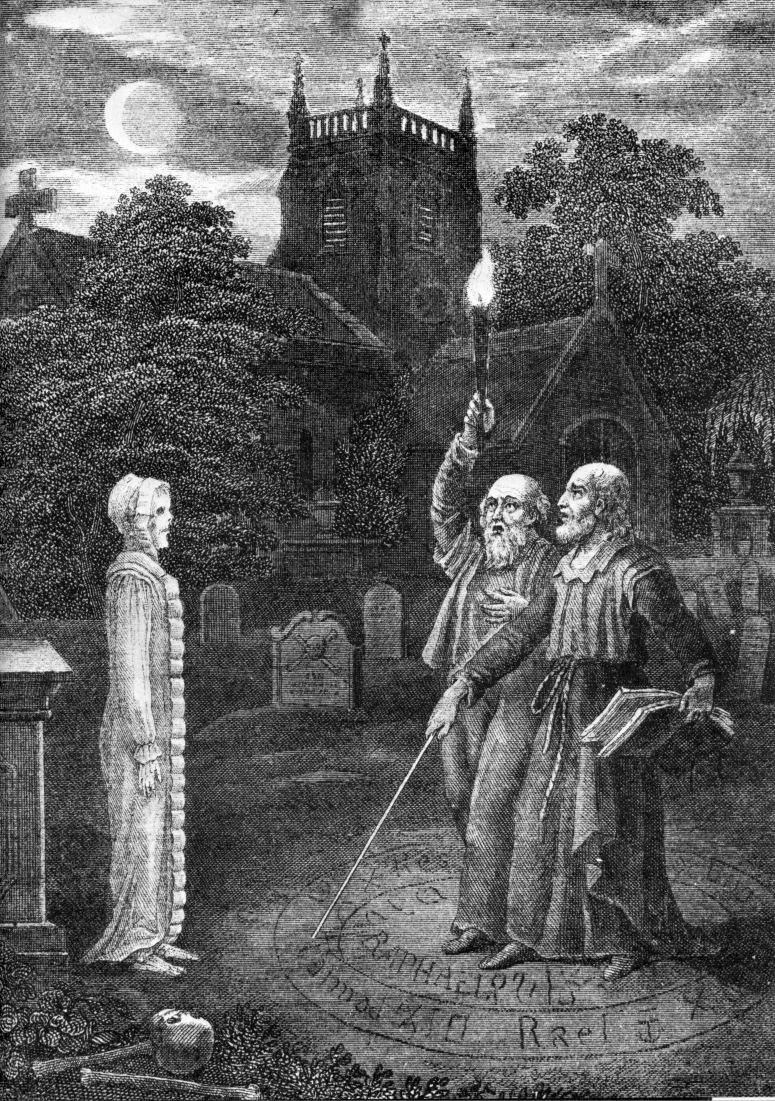Taghairm (also taigheirm) is a form of Scottish Celtic magic that involves the summoning of spirits or demons to foretell the future or to achieve some otherwise unreachable goal, such as great wealth. In that respect it is rather similar to the practice of necromancy
Form of magic in which the dead are re-animated and able to communicate with the sorcerer who invoked them, just as they would if they were alive., except that Celtic magicians rather rarely invoked the spirits of the dead.[1]
In its more benign form someone would be wrapped in the hide of a recently slaughtered bull and left beside a waterfall or at the foot of a precipice, places thought to be haunted by spirits. There he would contemplate on the question to be answered until inspiration arrived. The seer’s companions would sometimes attempt to deceive the spirits into believing that he was a log of birchwood, of the kind placed in cradles by fairies when they kidnapped children, so as to encourage their appearance by pretending that he was a changeling, one of their own.[2]
The most extreme form of taghairm involved the torture of black catsThe numerous folk beliefs about black cats, and cats in general, are often contradictory. Superstitions surrounding black cats are almost certainly some of the most prevalent even today, along with the number thirteen and walking under a ladder. . The best known case concerns Lachlan Oer and a companion who, in a barn near the Sound of Mull, impaled black cats on spits and roasted them alive. As with the gentler form of the practice, the intention was to compel supernatural beings to come to the aid of their own.[3] This procedure continued for four days, but at last an enormous black cat appeared and told Lachlan that if he did not desist he would never see God.[4] The cat was in reality the Devil, who after resuming his normal shape asked Lachlan and his companion what they wanted of him; they replied prosperity, and a long life to enjoy it, which was duly granted.[5]
Cameron of Lochiel is said to have received a small silver shoe at a taghairm, which if placed on the foot of a new-born son of his family would bestow courage and fortitude on the child. The foot of one baby boy was too big to fit in the shoe however, and the lad duly disgraced himself later in life by fleeing from the enemy at the Battle of Sherrifmuir (1751).[5]
The last report of the practice of taghairm, on the Island of Mull, appears in an 1824 article in the London Literary Gazette.[6]
References
Bibliography
{4928910:E3VZQGZ7};{4928910:F5GSE9BY};{4928910:E3VZQGZ7};{4928910:C4SN35BK};{4928910:E3VZQGZ7};{4928910:VIDPGCC7}
modern-language-association
author
asc
no
1
14401
%7B%22status%22%3A%22success%22%2C%22updateneeded%22%3Afalse%2C%22instance%22%3A%22zotpress-ec34f8e09d682189f22f8942095c3f29%22%2C%22meta%22%3A%7B%22request_last%22%3A0%2C%22request_next%22%3A0%2C%22used_cache%22%3Atrue%7D%2C%22data%22%3A%5B%7B%22key%22%3A%22VIDPGCC7%22%2C%22library%22%3A%7B%22id%22%3A4928910%7D%2C%22meta%22%3A%7B%22creatorSummary%22%3A%22Alexander%22%2C%22parsedDate%22%3A%222002%22%2C%22numChildren%22%3A0%7D%2C%22bib%22%3A%22%3Cdiv%20class%3D%5C%22csl-bib-body%5C%22%20style%3D%5C%22line-height%3A%202%3B%20padding-left%3A%201em%3B%20text-indent%3A-1em%3B%5C%22%3E%5Cn%20%20%3Cdiv%20class%3D%5C%22csl-entry%5C%22%3EAlexander%2C%20Marc.%20%3Ci%3EA%20Companion%20to%20the%20Folklore%2C%20Myths%20%26amp%3B%20Customs%20of%20Britain%3C%5C%2Fi%3E.%20Sutton%20Publishing%2C%202002.%3C%5C%2Fdiv%3E%5Cn%3C%5C%2Fdiv%3E%22%2C%22data%22%3A%7B%22itemType%22%3A%22book%22%2C%22title%22%3A%22A%20Companion%20to%20the%20Folklore%2C%20Myths%20%26%20Customs%20of%20Britain%22%2C%22creators%22%3A%5B%7B%22creatorType%22%3A%22author%22%2C%22firstName%22%3A%22Marc%22%2C%22lastName%22%3A%22Alexander%22%7D%5D%2C%22abstractNote%22%3A%22%22%2C%22date%22%3A%222002%22%2C%22language%22%3A%22%22%2C%22ISBN%22%3A%22978-0-7509-2359-0%22%2C%22url%22%3A%22%22%2C%22collections%22%3A%5B%22FSUYT4N7%22%5D%2C%22dateModified%22%3A%222019-07-29T23%3A10%3A08Z%22%7D%7D%2C%7B%22key%22%3A%22F5GSE9BY%22%2C%22library%22%3A%7B%22id%22%3A4928910%7D%2C%22meta%22%3A%7B%22creatorSummary%22%3A%22Draco%22%2C%22parsedDate%22%3A%222012%22%2C%22numChildren%22%3A0%7D%2C%22bib%22%3A%22%3Cdiv%20class%3D%5C%22csl-bib-body%5C%22%20style%3D%5C%22line-height%3A%202%3B%20padding-left%3A%201em%3B%20text-indent%3A-1em%3B%5C%22%3E%5Cn%20%20%3Cdiv%20class%3D%5C%22csl-entry%5C%22%3EDraco%2C%20Melusine.%20%26%23x201C%3BTaghairm.%26%23x201D%3B%20%3Ci%3EThe%20Dictionary%20of%20Magic%20and%20Mystery%3C%5C%2Fi%3E%2C%20John%20Hunt%20Publishing%2C%202012.%3C%5C%2Fdiv%3E%5Cn%3C%5C%2Fdiv%3E%22%2C%22data%22%3A%7B%22itemType%22%3A%22bookSection%22%2C%22title%22%3A%22Taghairm%22%2C%22creators%22%3A%5B%7B%22creatorType%22%3A%22author%22%2C%22firstName%22%3A%22Melusine%22%2C%22lastName%22%3A%22Draco%22%7D%5D%2C%22abstractNote%22%3A%22%22%2C%22bookTitle%22%3A%22The%20Dictionary%20of%20Magic%20and%20Mystery%22%2C%22date%22%3A%222012%22%2C%22language%22%3A%22%22%2C%22ISBN%22%3A%22978-1-84694-807-7%22%2C%22url%22%3A%22%22%2C%22collections%22%3A%5B%22AZM9F68Z%22%5D%2C%22dateModified%22%3A%222019-02-07T17%3A02%3A07Z%22%7D%7D%2C%7B%22key%22%3A%22E3VZQGZ7%22%2C%22library%22%3A%7B%22id%22%3A4928910%7D%2C%22meta%22%3A%7B%22creatorSummary%22%3A%22Spence%22%2C%22parsedDate%22%3A%221999%22%2C%22numChildren%22%3A0%7D%2C%22bib%22%3A%22%3Cdiv%20class%3D%5C%22csl-bib-body%5C%22%20style%3D%5C%22line-height%3A%202%3B%20padding-left%3A%201em%3B%20text-indent%3A-1em%3B%5C%22%3E%5Cn%20%20%3Cdiv%20class%3D%5C%22csl-entry%5C%22%3ESpence%2C%20Lewis.%20%3Ci%3EThe%20Magic%20Arts%20in%20Celtic%20Britain%3C%5C%2Fi%3E.%20Courier%20Dover%20Publications%2C%201999.%3C%5C%2Fdiv%3E%5Cn%3C%5C%2Fdiv%3E%22%2C%22data%22%3A%7B%22itemType%22%3A%22book%22%2C%22title%22%3A%22The%20Magic%20Arts%20in%20Celtic%20Britain%22%2C%22creators%22%3A%5B%7B%22creatorType%22%3A%22author%22%2C%22firstName%22%3A%22Lewis%22%2C%22lastName%22%3A%22Spence%22%7D%5D%2C%22abstractNote%22%3A%22%22%2C%22date%22%3A%221999%22%2C%22language%22%3A%22%22%2C%22ISBN%22%3A%22978-0-486-40447-9%22%2C%22url%22%3A%22%22%2C%22collections%22%3A%5B%22ZW5Q9G2E%22%2C%22D3LL5DV7%22%5D%2C%22dateModified%22%3A%222019-02-08T13%3A44%3A40Z%22%7D%7D%2C%7B%22key%22%3A%22C4SN35BK%22%2C%22library%22%3A%7B%22id%22%3A4928910%7D%2C%22meta%22%3A%7B%22creatorSummary%22%3A%22Staff%20writer%22%2C%22parsedDate%22%3A%221824-01-03%22%2C%22numChildren%22%3A0%7D%2C%22bib%22%3A%22%3Cdiv%20class%3D%5C%22csl-bib-body%5C%22%20style%3D%5C%22line-height%3A%202%3B%20padding-left%3A%201em%3B%20text-indent%3A-1em%3B%5C%22%3E%5Cn%20%20%3Cdiv%20class%3D%5C%22csl-entry%5C%22%3EStaff%20writer.%20%26%23x201C%3BTraditions%20of%20the%20Western%20Highlands.%20No.%2011.%20The%20Taigheirm.%26%23x201D%3B%20%3Ci%3EThe%20Literary%20Gazette%3C%5C%2Fi%3E%2C%203%20Jan.%201824%2C%20p.%20172%2C%20%3Ca%20target%3D%27_blank%27%20href%3D%27https%3A%5C%2F%5C%2Fbabel.hathitrust.org%5C%2Fcgi%5C%2Fpt%3Fid%3Dnyp.33433085032278%3Bview%3D1up%3Bseq%3D182%3Bsize%3D150%27%3Ehttps%3A%5C%2F%5C%2Fbabel.hathitrust.org%5C%2Fcgi%5C%2Fpt%3Fid%3Dnyp.33433085032278%3Bview%3D1up%3Bseq%3D182%3Bsize%3D150%3C%5C%2Fa%3E.%3C%5C%2Fdiv%3E%5Cn%3C%5C%2Fdiv%3E%22%2C%22data%22%3A%7B%22itemType%22%3A%22newspaperArticle%22%2C%22title%22%3A%22Traditions%20of%20the%20Western%20Highlands.%20No.%2011.%20The%20Taigheirm%22%2C%22creators%22%3A%5B%7B%22creatorType%22%3A%22author%22%2C%22firstName%22%3A%22%22%2C%22lastName%22%3A%22Staff%20writer%22%7D%5D%2C%22abstractNote%22%3A%22%22%2C%22date%22%3A%223%20January%201824%22%2C%22section%22%3A%22%22%2C%22language%22%3A%22%22%2C%22ISSN%22%3A%22%22%2C%22url%22%3A%22https%3A%5C%2F%5C%2Fbabel.hathitrust.org%5C%2Fcgi%5C%2Fpt%3Fid%3Dnyp.33433085032278%3Bview%3D1up%3Bseq%3D182%3Bsize%3D150%22%2C%22collections%22%3A%5B%22I84FVMAP%22%5D%2C%22dateModified%22%3A%222019-02-07T17%3A49%3A02Z%22%7D%7D%5D%7D
Alexander, Marc. A Companion to the Folklore, Myths & Customs of Britain. Sutton Publishing, 2002.
Draco, Melusine. “Taghairm.” The Dictionary of Magic and Mystery, John Hunt Publishing, 2012.
Spence, Lewis. The Magic Arts in Celtic Britain. Courier Dover Publications, 1999.
Staff writer. “Traditions of the Western Highlands. No. 11. The Taigheirm.”
The Literary Gazette, 3 Jan. 1824, p. 172,
https://babel.hathitrust.org/cgi/pt?id=nyp.33433085032278;view=1up;seq=182;size=150.

